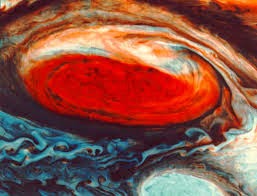Familiar white or transparent ice;
a black allotrope on the Jovian surface;
super-dense ice in the mantle around the Jovian core;
red crystalline ice floating in the Jovian atmosphere.
The Red Spot is a storm according to Wikipedia (see here) but "'...a mass of aerial pack ice...'" (Sir Dominic Flandry, p. 185) according to Dominic Flandry. Hence, the fourth kind of ice listed here.
In the Technic History:
"'...always, Chives, the Red Spot is a pack of flying glaciers, stretching broader than all Terra. And we've been crashed on one of them!'" (ibid.)
- crashed in a vehicle protected by a force-field although the field may fail in the dense, violent atmosphere and, in any case, food and air will run out unless Flandry and Chives can attract help which, of course, they do.
It was interesting to find a link to the Red Spot only to discover that it gives a different account of this phenomenon but that is the relationship between science and science fiction. The science moves on. The fiction moves with it but, if earlier fictions were worthwhile, then they are still appreciated, with their earlier versions and visions of the Solar planets.
It is on this occasion that Flandry says:
"'I don't want to die so fast I can't feel it. I want to see death coming, and make the stupid thing fight for every centimeter of me.'" (p. 184)
For those of us who disbelieve in a hereafter, this is an intriguing thought. We can die in our sleep or can be killed instantaneously by an explosion. In these cases, we do not realize that our last moment of consciousness is our last. Like Flandry, I would prefer to see death coming but would not, at the very end, want to fight it. Life's limits, its beginning and its end, are not "stupid."
Dylan Thomas wrote, "Rage, rage against the dying of the light." I do not want to die enraged.


No comments:
Post a Comment